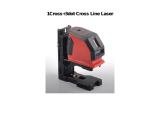
5 Safety instructions
WARNING: Ensurethat you read all safety precautions
and instructions.Failure to observe the safety precau-
tions and instructions may result in electric shock, fire
and/or serious injury. Retain all safety precautions and
instructions for future reference.
5.1 General safety measures
a) Check the accuracy of the tool before use and
several times during use.
b) The tool and its ancillary equipment may present
hazards when used incorrectly by untrained per-
sonnel or when used not as directed.
c) Stayalert, watchwhat you are doing and usecom-
mon sense when operating the machine. Don’t
use the machine when you are tired or under the
influence of drugs, alcohol or medication. Amo-
ment of inattention while operating machines may
result in serious personal injury.
d) Modification of the tool is not permissible.
e) Do not render safety devices ineffective and do
not remove information and warning notices.
f) Keep children and other persons away from the
area while the tool or appliance is in use.
g) Take the influences of the surrounding area into
account. Do not expose the tool to rain or snow
and do not use it in damp or wet conditions. Do
notusethetoolwherethereisariskoffireor
explosion.
h) Maintain the machine carefully. Check for mis-
alignment or binding of moving parts, breakage
of parts and any other condition that may affect
the machine’s operation. If damaged, have the
machine repaired before use. Poor maintenance is
the cause of many accidents.
i) Have your power tool serviced by a qualified re-
pair person using only identical replacement parts.
This will ensure that the safety of the power tool is
maintained.
j) The user must check the accuracy of the tool
after it has been dropped or subjected to other
mechanical stresses.
k) When the tool is brought into a warm environment
from very cold conditions, or vice-versa, allow it
to become acclimatized before use.
l) Make sure that the tool is mounted securely when
adapters or accessories are used.
m) Keep the laser exit aperture clean to avoid meas-
urement errors.
n) Although the tool is designed for the tough condi-
tions of jobsite use, as with other optical and elec-
tronic instruments (e.g. binoculars, spectacles,
cameras) it should be treated with care.
o) Do not use a tool if its switch is defective. Atool
that cannot be controlled by the switch (switched on
and off) is dangerous and must be repaired.
p) To achieve maximum accuracy, project the line
onto a vertical, flat surface. When doing so, set
up the tool at 90° to the surface.
5.2 Proper organization of the workplace
a) Secure the area in which you are working and
take care to avoid directing the beam towards
other persons or towards yourself when setting
up the tool.
b) Measurements taken through panes of glass or other
objects may be inaccurate.
c) Ensure that the tool is set up on a steady, level
surface (not subject to vibration).
d) Use the tool only within its specified limits.
e) If several laser tools are used in the same working
area, care must be taken to avoid confusing the
beams.
f) Strong magnetic fields may affect the accuracy of
the tool. Magnetic objects should thus be kept away
from the measuring tool. Hilti magnetic adapters may
be used.
g) Do not use the tool in the proximity of medical instru-
ments.
5.3 Electromagnetic compatibility
Although the tool complies with the strict requirements
of the applicable directives, Hilti cannot entirely rule out
the possibility of the tool being subject to interference
caused by powerful electromagnetic radiation, leading
to incorrect operation. Check the accuracy of the tool
by taking measurements by other means when working
under such conditions or if you are unsure. Likewise, Hilti
cannot rule out the possibility of interference with other
devices (e.g. aircraft navigation equipment).
5.4 Laser classification for laser class 2/class II
tools
Depending on the version purchased, the tool complies
with Laser Class 2 in accordance with IEC825-1:2007 /
EN60825-1:2007 and Class II in accordance with CFR
21 § 1040 (FDA). This tool may be used without need
for further protective measures. Nevertheless, as with the
sun, one should not look directly into sources of bright
light. In the event of direct eye contact with the laser
beam, close your eyes and move your head out of the
path of the laser beam. Do not direct the laser beam
toward persons.
5.5 Electrical
a) Remove the batteries before storing or transport-
ing the tool.
b) Keep the batteries out of reach of children.
c) Do not allow the batteries to overheat and do not
expose them to fire. The batteries may explode or
release toxic substances.
d) Do not charge the batteries.
e) Do not solder the batteries into the tool.
f) Do not discharge the batteries by short circuiting
as this may cause them to overheat and present
a risk of personal injury (burns).
en
13
Printed: 27.10.2015 | Doc-Nr: PUB / 5187365 / 000 / 02














